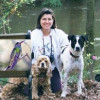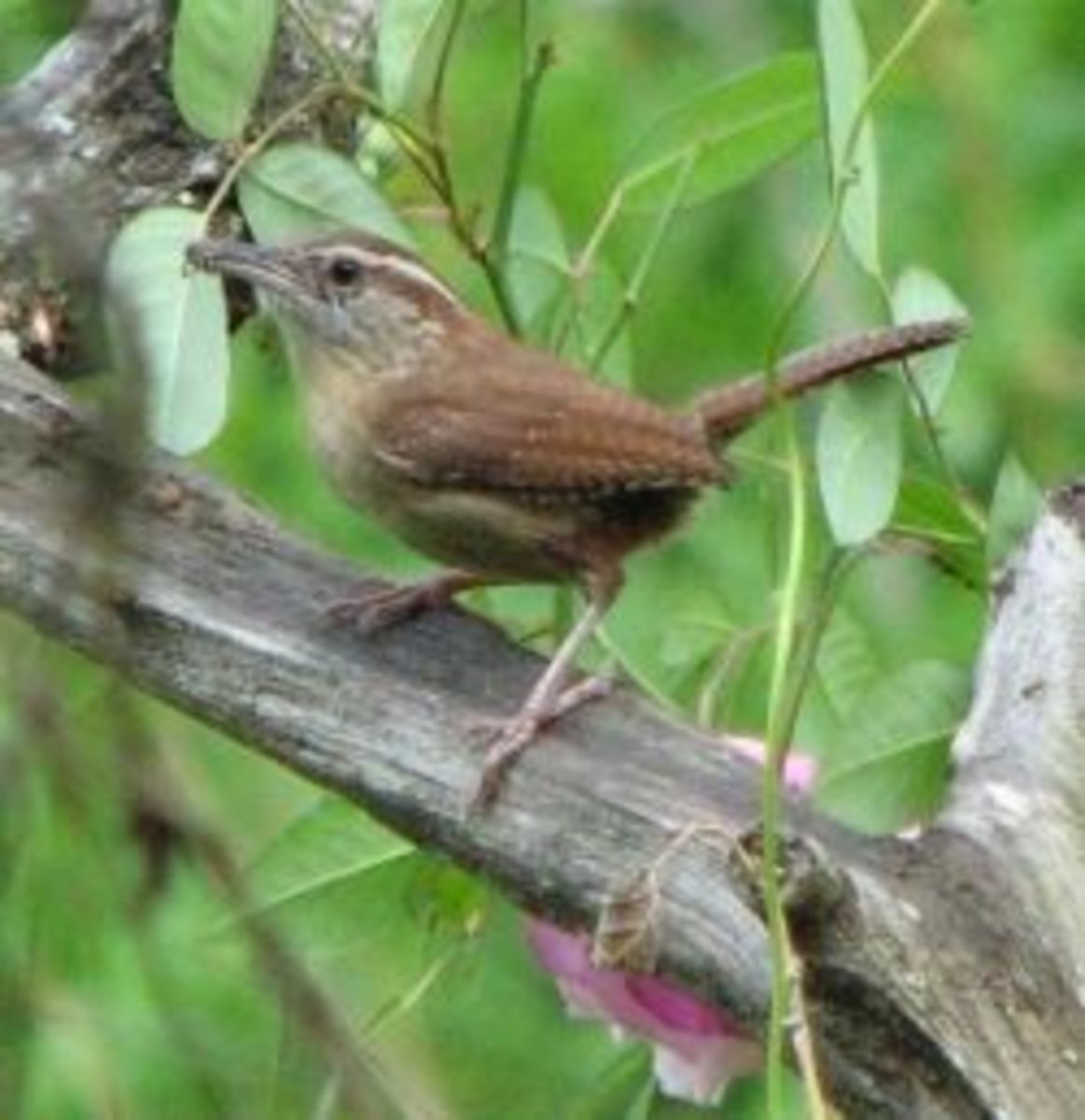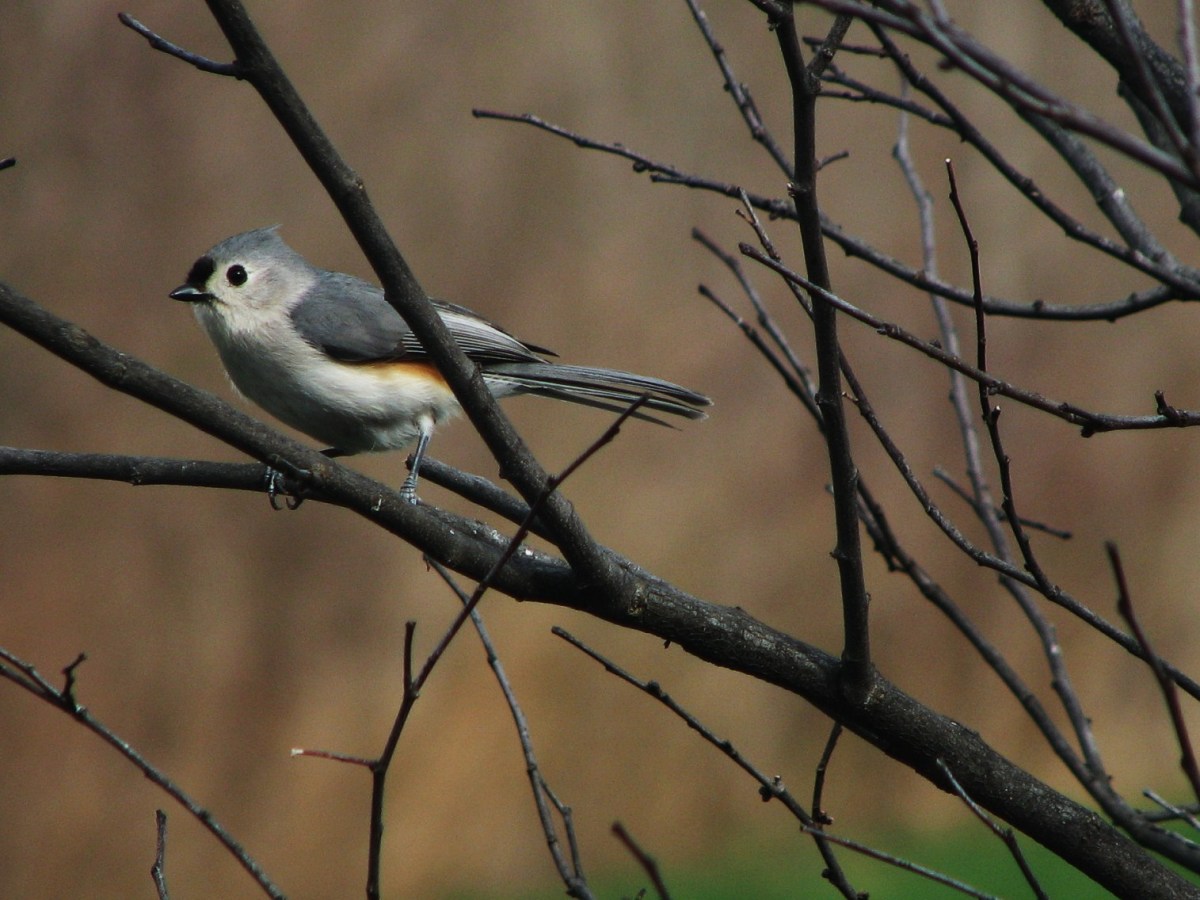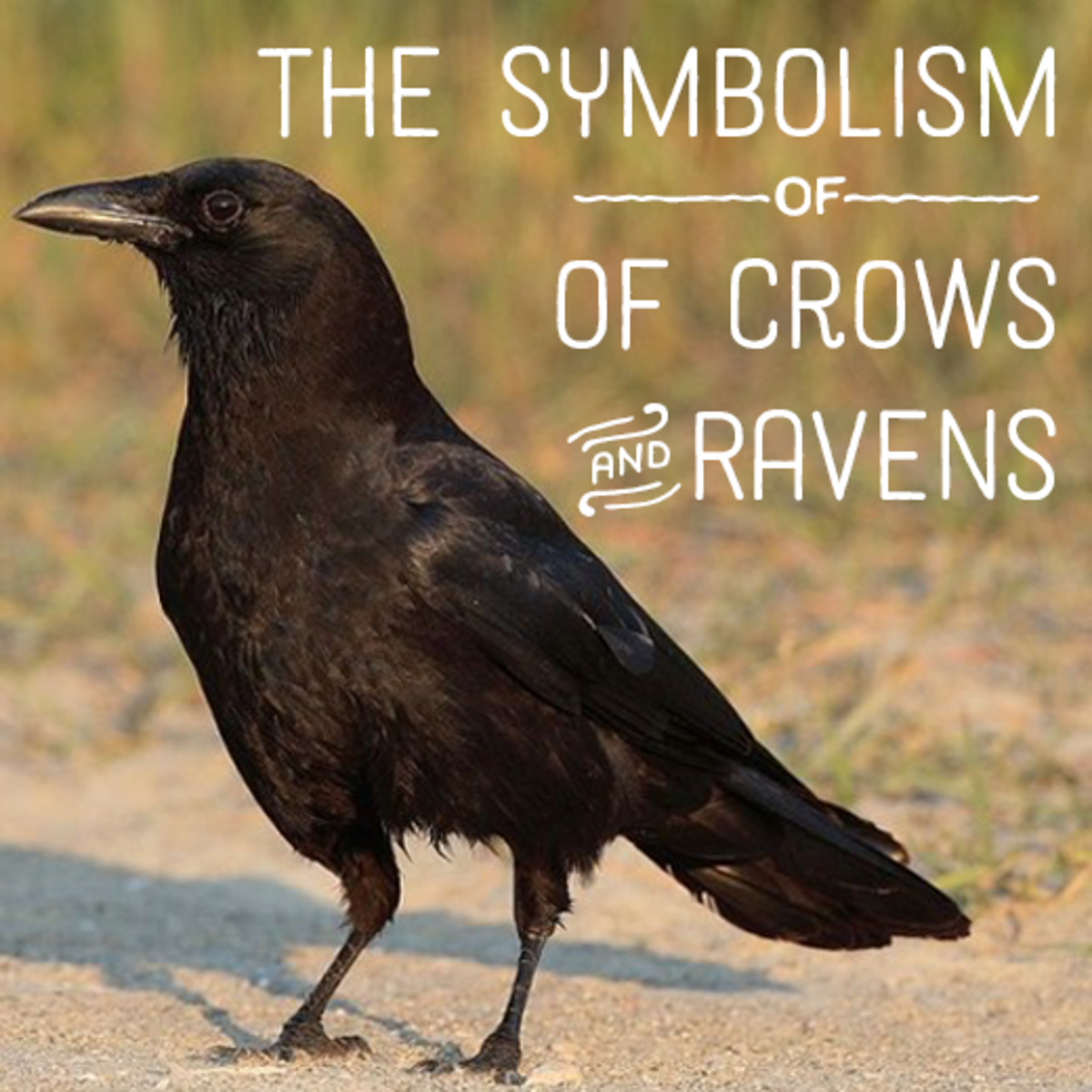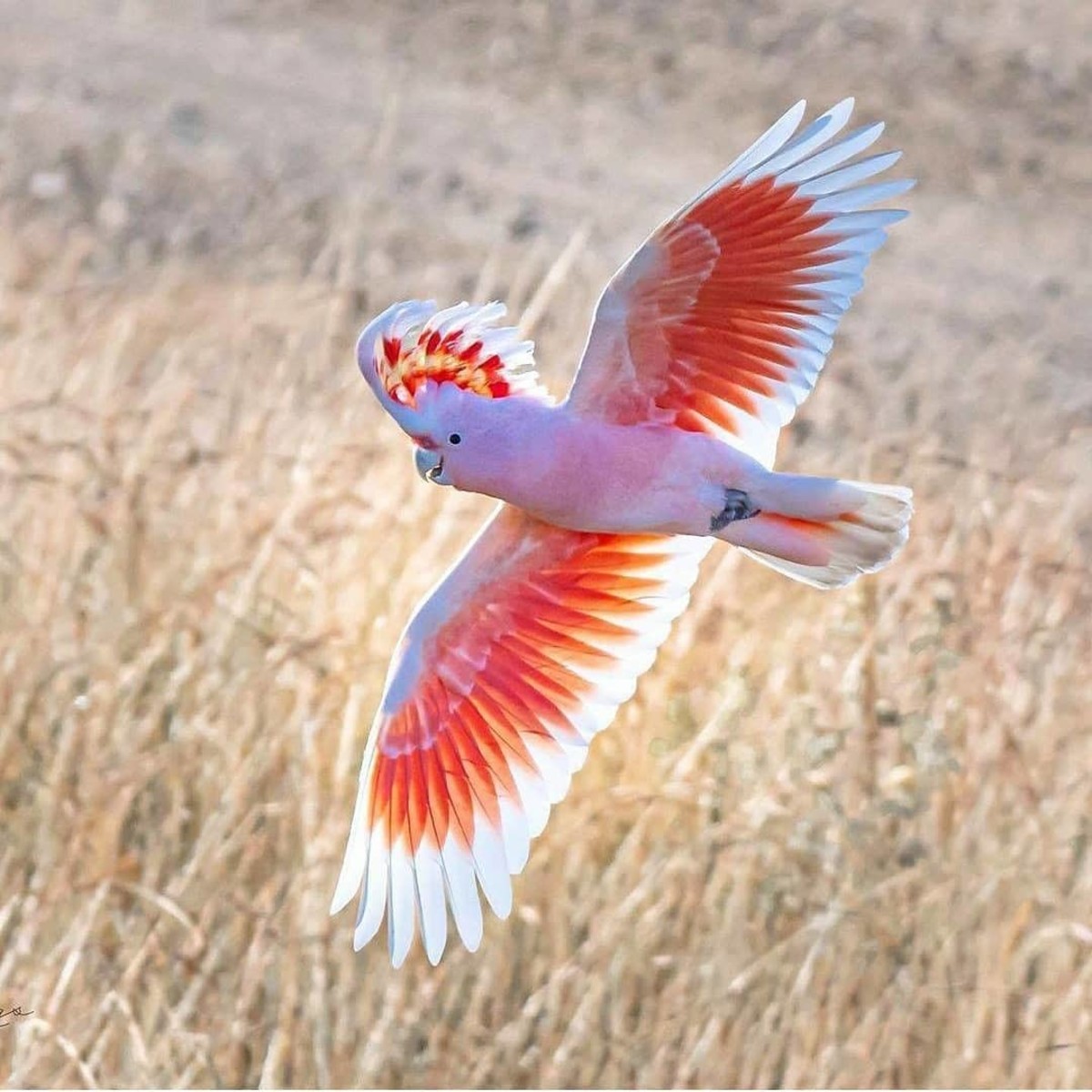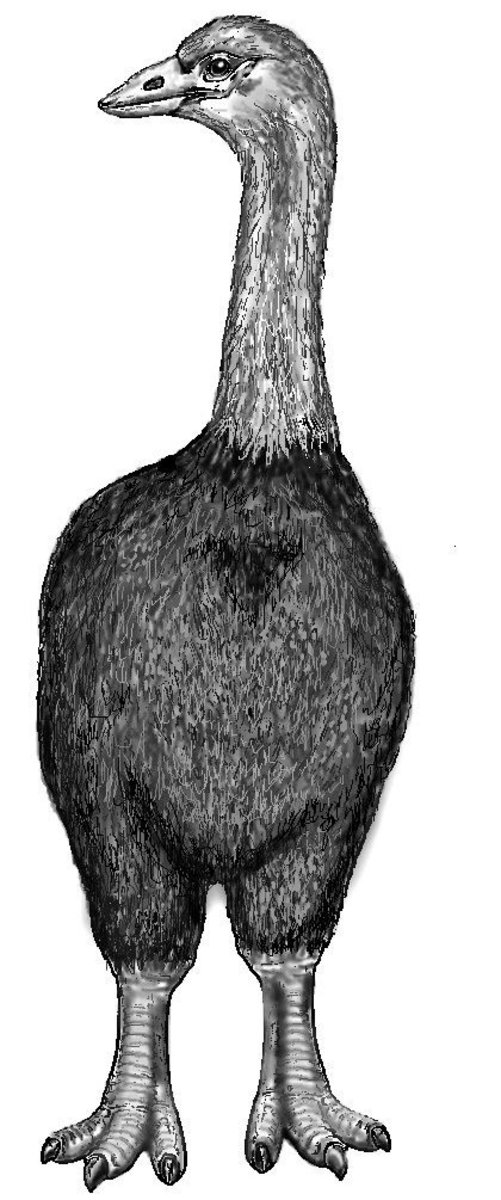Nest Box Trails for Bluebirds and Others
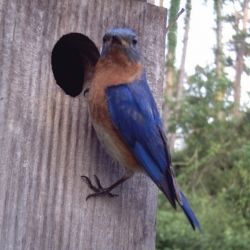
Building Nest Box Trails for Cavity Nesting Birds
Lawrence Zeleny's book, "the Bluebird How You Can Help Its Fight for Survival", alerted the public about the peril of our native Bluebirds. Now people all over North America are building and maintaining Bluebird Trails. Anyone can start their own trail right in their own back yard with a single, well built, well placed and well protected nest box or bird house.
This page will help you start your own nest box "trail", which will help Bluebirds in their struggle for survival. Such trails will also provide nesting sites for many other of our wild and wonderful cavity nesting birds such as Prothonotary Warblers, Carolina Chickadees, Tufted Titmice, Carolina Wrens and more. You will also find lists of native plants and easy to grow introduced plants that will attract Bluebirds and other cavity nesting birds to your property.
Nesting Bluebirds Poll
How many times has a pair of Bluebirds nested in your area?
Curious Male Eastern Bluebird
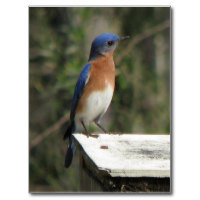
Description
The Eastern Bluebird, Sialia sialis, is a beautiful blue, medium-sized thrush found in open woodlands, farmlands and orchards.
Adults have a white belly. Adult males are bright blue on top and have a reddish brown throat and breast. Adult females have lighter blue wings and tail, a lighter cinnamon throat and breast and a gray crown and back. Eastern Bluebirds are found east of the Rockies, southern Canada to the Gulf States and southeastern Arizona to Nicaragua.
Female on Box
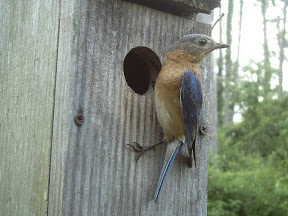
The bright blue breeding plumage of the male and its cheerful song makes this species a favorite of birders. The male's call includes sometimes soft warbles of jeew or chir-wi or the melodious song chiti WEEW wewidoo (Sibley, 2000).
Listen to the Song of the Eastern Bluebird from the National Park Service
Bluebirds feed primarily on insects. According to Martin, Zim and Nelson in American Wildlife & Plants - A Guide to Wildlife Food Habits the choice animal food items that they eat includes: Beetles, particularly ground beetles, May beetles and weevils, grasshoppers and crickets and caterpillars. Various other insects and spiders, centipedes, sowbugs and snails are also eatern. And that is where they get the nickname of "the farmer's friend". They will also feed on fleshy fruits and small berries like Black Cherry, Huckleberries (Blueberries), Holly, Flowering Dogwood, Virginia-creeper, Hackberry, Sumac, Elderberry and Service Berry.
Bluebirds nest in natural cavities in trees and fence posts. They will also eagerly use man made nest boxes.
Bluebird Monitor's Guide...

What is a Nest Box Trail
Bluebirds were once a common site throughout the United States, but in the 1970s scientists and some bird watchers realized that something was wrong. Bluebird numbers were way down. It was thought that the lack of available natural cavities for nesting might be the reason. Lawrence Zelaney started the Bluebird Trail movement which brought Bluebirds back so that today, our children can enjoy the bright blue color and gentle warbling song of the Bluebird of happiness. People maintain Bluebird trails all over North America. A trail can consist of 1 or 2 or hundreds of nest boxes.
Starting your own nest box trail is not that difficult, but more is involved than just putting up the nest box(es). You must be willing to monitor and maintain the trail. Good monitors check each box at least once a week during nesting season and they keep records detailing the kind of birds, when the nest was built, the number of eggs laid and the number of young hatched and fledged. The bird houses must also be cleaned out at the end of the breeding season. Most monitors clean the nest out right after the young fledge because the birds seem to prefer nesting in clean houses and many times a pair will use the same birdhouse for a second nesting if the old nest is removed. Winter maintenance is also necessary so that the boxes are kept in good condition.
Prothonotary Warbler on Box
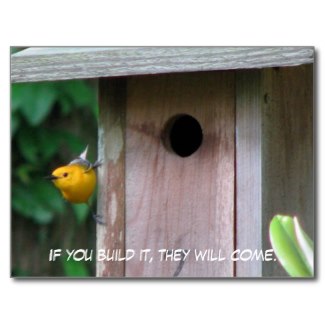
Our Bluebird Trail
We have been maintaining a nest box trail on our property since 1999. Because of our land's versatile terrain, our nest boxes attract a variety of birds and animals. Many of the nest boxes are in a forested area so we don't get as many Eastern Bluebirds as we would like. But even though only 1-2 Bluebird pairs use our Bluebird Trail, we are fortunate to have been able to help the Prothonotary Warbler, whose numbers are decreasing due to habitat destruction and loss of natural cavities. Other birds that use our boxes include Carolina Chickadees, Tufted Titmice, Carolina Wrens, Brown-headed Nuthatches, Great Crested Flycatchers and Screech Owls. Other animals we've found in residence are Flying Squirrels, Cotton Rats and Bumblebees.
Bluebirds in the Garden
Male Watching Over His Mate
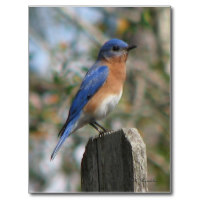
Male on Stovepipe Predator Baffle
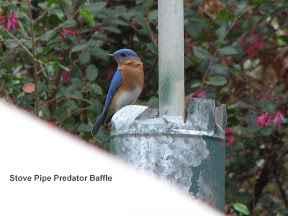
Nest Box Design
The old adage, "An ounce of prevention is worth a pound of cure", holds true when it comes to putting up nest boxes. If you put forth a little more effort initially to provide the most beneficial situation for the cavity nesting birds that you are trying to attract it will save a lot of time and heart ache in the long run. Here are a few pointers that will help make your nest box experience a positive one.
* Do Not Put Nest Boxes on Trees or Utility Poles. This is a recipe for disaster because trees are the first place predators look. Mounting on trees also makes boxes difficult to monitor. If you regularly monitor nest boxes, potential problems (like bees and wasps or predators) can normally be nipped in the bud before they get out of hand and kill young.
* Predator Baffles Save Lives. Many predators such as racoons, snakes, cats, starlings and crows can be foiled by good predator baffles and some modifications (like a large overhanging roof) to the nest boxes. Simple designs that are easy to construct can be found at the North American Bluebird Society Website.
* Nest box Design is Extremely Important. The roof should extend out to protect the birds from reaching predators and to shade from the summer sun. Hole size (1 1/2" diameter for Bluebird), nest box depth and sturdy construction are also important and in the hot, humid south good ventilation is crucial. Bluebird and smaller bird nest box plans can be found at theNorth American Bluebird Society.
A standard, North American Bluebird Society approved nest box will be used by Bluebirds and, depending on the part of the country that you live in, many other species of birds, including Carolina and Black Capped Chickadees, Tufted Titmice, Carolina Wren, Prothonotary Warblers, Brown-headed Nuthatches, Tree Swallows and Great Crested Flycatchers, etc. The size of the entrance hole will determine type of bird (or animal) will use the house. Bluebirds prefer a hole with a 1 1/2 inch diameter and many of the other birds I listed will use houses with this size hole, too. Plans for boxes for larger birds can be found in pdf file format from North Prairie Wildlife Research Center.
Building a Bluebird house can be a family affair and monitoring the box will be a learning experience for one and all. The first step to becoming a scientist is to learn to be a good observer and to record those observations accurately. We need more ornithologists and other scientists.
Boxes for Birds
Spring Pair House Hunting
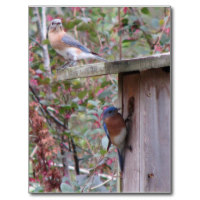
Photo Journal: Life Cycle of the Eastern Bluebird
Males stake out a territory containing several good nesting sites. Once the female has decided on one, she begins to build the nest, while the male keeps watch. The nest is made of grasses, plant stems, pine needles, and is lined with hair or fine grasses. Once the nest is complete, the female lays 3-7 pale blue eggs. Occasionally the eggs are white.
Female on Nest Box
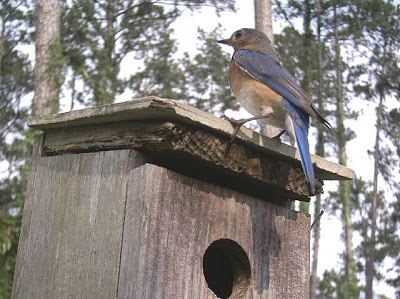
The female incubates the eggs for 11-19 days. When the young hatch they are helpless. Their eyes are closed and they have no feathers.
1 Day Old Chicks
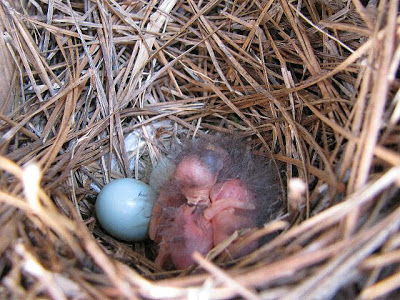
The babies grow fast and before you know it little quills are forming on the wings. In the first picture below, the babies are about a week old. In the second one, they are about 2 weeks old.
Chicks Beginning to Show Color
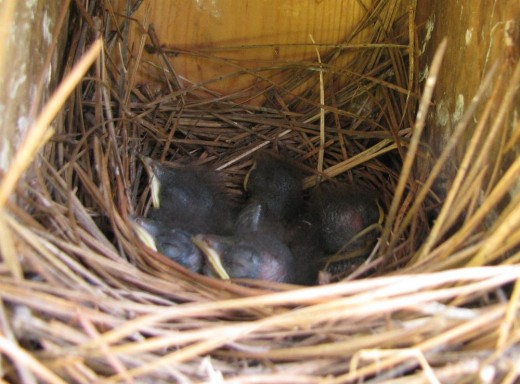
Feathered and Close to Fledging
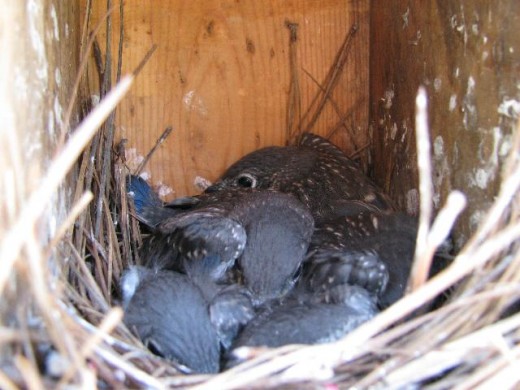
For the next 17 to 19 days, both parents feed the young a variety of progressively larger insects. The young fledge (leave the nest) within 17-20 days.
It's a Big World Out There
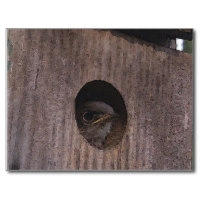
The babies peer out into the great big world out there. It takes awhile before the first one finally jumps.
Ready to Make the Jump
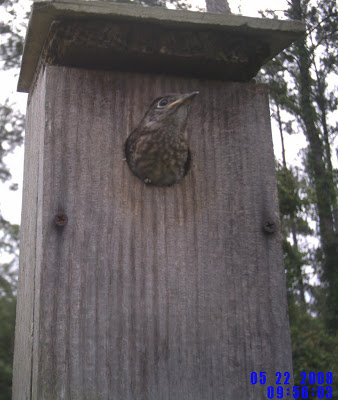
By 12:51 p.m. they are all out and just in time because a storm is coming. It rained all afternoon and into the night.
Maybe Now I'll Go
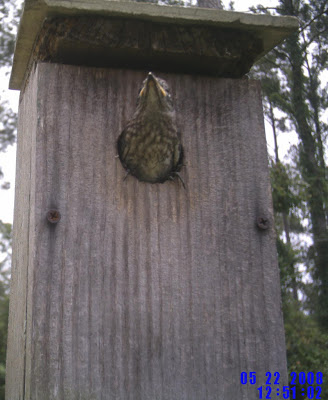
The male Eastern Bluebird will often keep feeding the fledglings while the female begins a second nest.
Wingscapes Birdcam with Flash
The Bird Cam that we used to take many of the pictures in the photo journal of the bluebird nest box has been discontinued, so when we have replaced it with a Wingscape Bird Cam with a flash, like the one below.
Cameras to Monitor the Nest Box
There are several electronic options to help monitor a nest box. Automatic, motion sensor cameras can be set up outside the nest box to capture the comings and goings of the parents. These cameras will also capture predators such as racoons, cats and others.
Small video (spy-type) cameras are also available that can be mounted either inside or outside the nest box. These must be connected to a vcr, dvd recorder or a computer. The Sialis.org page has detailed info about these cameras.
The Moultrie game cameras will take video during the day and photographs day or night. Some are infrared and some use a flash for night time photos.
Supplemental Food
A wide variety of cavity nesting birds like to eat suet. We put it out all year long, so we make a special "no-melt" kind. You'll find the recipe below.
Carolina Chickadee on Suet
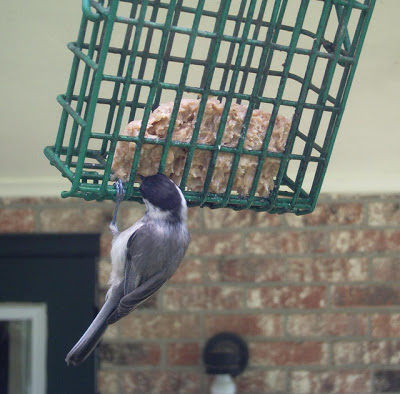
Home Made Suet
2 cups (1 block) of LARD (animal fat)
1 cup CRUNCHY Peanut butter (cheap kind)
1 cup of Oatmeal
1 cup of unbleached flour
1 cup of cornmeal or wheat germ
Melt the lard a little in a big glass bowl (30 sec. in the microwave) and mix all of the ingredients together. It gets messy so let the kids get involved, they'll love it! Line a rectangular pan with a sheet of wax paper and press the mixture in. Pop it in the freezer for an hour or so, then cut it into blocks. We find that smaller ones (4" x 2") work best because the birds eat it before it can mildew in the hot, humid weather. Store the blocks in a ziploc bag in the freezer and refill your suet feeder as needed.
Mealworm Facts
Bluebirds like to eat mealworms especially when they are nesting. Mealworms are the larval form of an imported beetle called the mealworm beetle, Tenebrio molitor, a species of darkling beetle. The darkling beetle goes through four life-stages: egg, larva, pupa, and adult. Larvae typically measure about 2.5cm or more, whereas adults are generally between 1.25 and 1.8cm in length.
Mealworms are used as a food source for reptile and avian pets. They are also put out for wild birds in bird feeders, particularly during the nesting season when birds are raising their young. They can be purchased at most pet stores and are also available via mail order and the internet. Mealworms are usually sold in a container with bran or oatmeal for food. Mealworm feeders are available on-line or you can make your own. Mealworms are easy to raise and many lessons can be learned during the process.
Attracting Bluebirds Video
~~~~~~~~~~~~~~~~~~~~~~~~~~
A man's interest in a single bluebird is worth more than a complete but dry list of the fauna and flora of a town.
~~~~~~~~~~~~~~~~~~~~~~~~~~
— Letter, November 22, 1858, from Henry D. Thoreau to Daniel Ricketson, in The Writings of Henry DavidInteract With Other Bluebird Trail Monitors
The best way to learn about managing a bluebird trail is to speak with experienced people who have been successful with their trail. The following link will send you to a forum with 3 different discussion lists about Bluebirds and other cavity nesting birds. Join one or all and learn more about Bluebirds.
Branded BluebirdLouisiana Bayou Bluebird SocietySticky Bluebird / FAQs- BLUEBIRD CONFERENCES - PMS, NA Round Table Conferences
The Bluebird Conferences provide information for bluebird managers and their endeavor to promote bluebird conservation
Bluebird flying high,
Tell me what you sing.
If you could talk to me,
What news would you bring
Of voices in the sky?
— The Moody Blues, In Search of the Lost Chord, lyrics from Voices in the Sky, Justin Hayward, 1968Information and Education
The nesting cycle of the Bluebirds and related subjects are ripe with learning opportunities. You may want to check out some of the outstanding pages below.
More Blues and Birds
- Eggs and Easter Teaching Unit
This 4th grade thematic teaching unit on eggs and Easter includes lesson plants, a bibliography, audio-visual materials and crafts. Designed for small groups in a classroom or homeschool. - Birds That Nest in Boxes
Here you'll find photos and information about cavity nesting birds and animals including bluebirds, chickadees, wrens, Prothonotary warblers, woodpeckers, owls, wood ducks, and flying squirrels. - Bluebirds and Their Boxes
Come learn about bluebirds and how they nest. You can help this beautiful insect eater by erecting a birdhouse built just for it. On this page are photos, info and links about nesting bluebirds. - Bluebirds ~ Pictures of Bluebirds~Bluebird Houses~Attracting Bluebirds
A pair of Eastern Bluebirds make their home in a backyard nesting box. Photos of bluebirds, bluebird nests and baby bluebirds included. Tips on attracting bluebirds to your backyard.
© 2008 Yvonne L B
